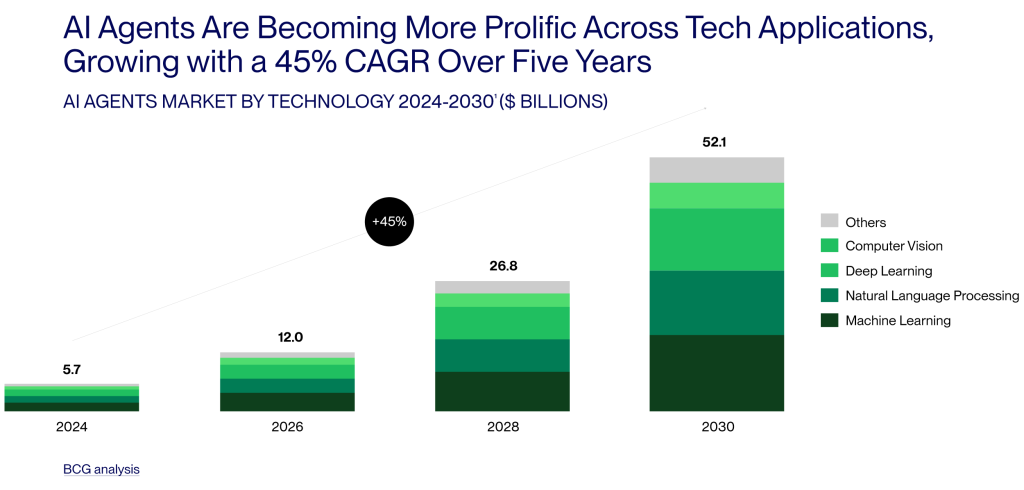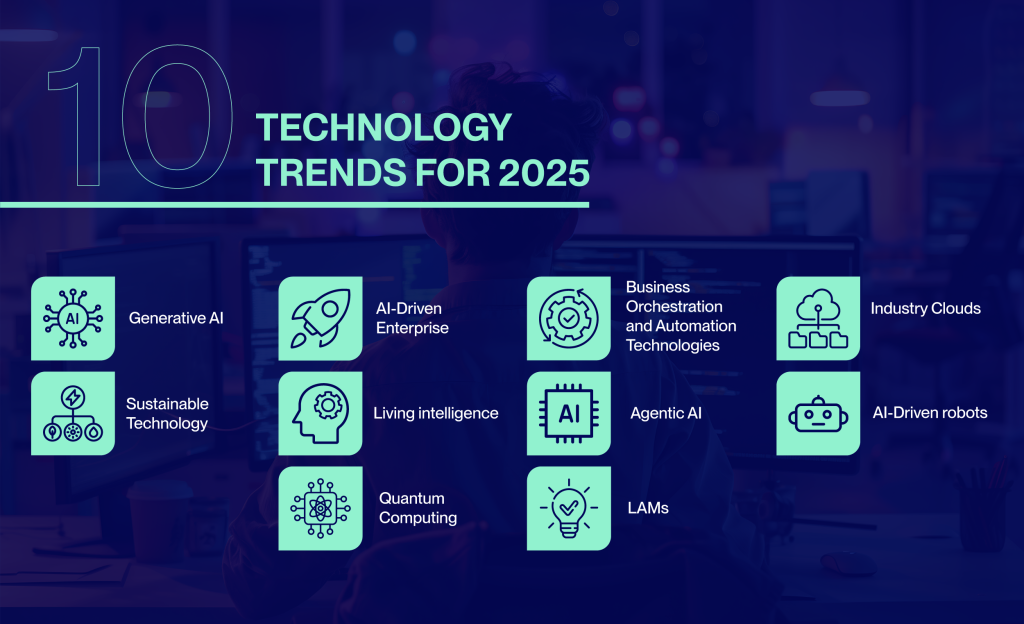Discussing technology trends in 2025 inevitably involves highlighting the growing prominence of artificial intelligence. This technology has evolved significantly, branching out into various forms and applications — intelligent automation, predictive analytics, computer vision, and recommendation systems — and has become a cross-cutting pillar in digital transformation initiatives across organizations worldwide.
The fact that artificial intelligence takes center stage in this year’s special report on technology trends reflects the market’s sustained interest and the increasing investment in AI-based solutions. In 2024, generative AI caught the attention of companies and analyst firms, thanks to its disruptive power and immediate impact on many areas, including marketing, design, customer service, and software development. The accessibility of this technology, along with advancements in language models and content generation capabilities, has driven mass adoption and showcased AI’s potential in unprecedented ways. This growing influence has been further reinforced by the fact that, since mid-2023, GEN AI has become a central topic at numerous conferences hosted by leading analyst firms such as Gartner and IDC.
Looking ahead, all signs point to the next wave of innovation emerging from “living intelligence”. This emerging trend stems from the convergence of artificial intelligence, advanced sensors, and biotechnology, giving rise to systems capable of perceiving, learning, and evolving autonomously, going beyond the limits of human programming.
Alongside living intelligence, other trends expected to shape the technological and business ecosystem in 2025 include LAM models, BOAT platforms, quantum computing, and agent-based AI.
Within this context, if your organization is considering new digital transformation investments to boost competitiveness, drive sustainability, and foster innovation, we invite you to explore this report — a publication we update annually, offering in-depth analysis of the strategic technology trends with the greatest impact projected for 2025.
List of strategic technology trends for 2025
 Technology trend 1 | LAMs
Technology trend 1 | LAMs
LAM stands for Large Action Models, also known as large-scale action models. These represent a new generation of AI systems that go beyond the capabilities of traditional Large Language Models (LLMs). While LLMs are limited to processing and generating natural language, LAMs are designed to autonomously execute actions in digital environments. They act as intelligent agents that interact with software interfaces to perform complex tasks that previously required human intervention.
For instance, while an LLM can respond to a customer service inquiry, a LAM can autonomously manage the activation or cancellation of a service related to that inquiry.
The operation of a LAM is based on the integration of several interrelated components:
- Large Language Model (LLM): This is the foundational element of any LAM. A pretrained LLM is used to understand natural language, interpret complex instructions, reason through them, and generate coherent responses. This linguistic core is essential for interpreting commands and planning actions within the model.
- LLM fine-tuning or RLHF: To specialize an LLM in specific tasks, fine-tuning techniques are applied, such as supervised learning, reinforcement learning with human feedback (RLHF), artificial feedback (RLAIF), and direct preference optimization (DPO). In many cases, these are combined with multimodal training (text, images, audio), enhancing the model’s capacity to operate in complex and varied contexts.
- External tools: This component differentiates LAMs from conventional LLMs. Through integration with graphical interfaces, APIs, and other software applications, LAMs can autonomously execute actions like clicking, filling out forms, sending emails, or interacting with systems.
A notable example of a Language Action Model (LAM) is ACT-1, developed by Adept AI. Designed to perform actions directly within digital applications, ACT-1 translates natural language instructions into precise operations across graphical user interfaces. It can autonomously coordinate complex tasks spanning multiple apps, all without human oversight.
Other models, such as Claude 3.5 Sonnet, while technically categorized as large language models (LLMs), exhibit similar autonomous capabilities. Claude 3.5 Sonnet can navigate digital environments and complete tasks within visual interfaces, closely mimicking the behavior of a human user.
 Technology trend 2 | Agentic AI
Technology trend 2 | Agentic AI
Agentic AI represents a new technological leap, with autonomous systems capable of making decisions, setting and achieving goals by executing complex strategies without continuous human oversight. This emerging trend will reshape how humans interact with machines and transform technological capabilities in managing business operations. These systems can assume operational responsibilities independently.
Unlike traditional AI systems that are limited to pattern recognition and predictive analysis, AI agents understand the context of situations and adapt strategies based on changing conditions. Beyond responding to instructions like traditional systems, they identify opportunities, define objectives, and coordinate the necessary resources to fulfill them. Moreover, agents can work collaboratively. Each one specializes in a specific task, but together they form intelligent networks capable of solving complex and dynamic problems.
According to a study by Boston Consulting Group, AI agents are rapidly gaining ground with a wide range of applications and use cases, including customer service, legacy system modernization, and R&D. In fact, the consulting firm projects that the AI agent market will grow at a compound annual growth rate (CAGR) of 45% between 2024 and 2030.
On the other hand, AI agents present certain challenges related to security, regulatory compliance, and control over system autonomy. As a result, many companies have chosen to implement pilot projects in well-defined areas, such as inventory management or predictive maintenance.

 Technology trend 3 | Business Orchestration and Automation Technologies
Technology trend 3 | Business Orchestration and Automation Technologies
In 2024, a prominent analyst firm introduced the concept of Business Orchestration and Automation Technologies (BOAT) at one of its innovation and enterprise tech conferences. The term quickly gained traction in industry media and among companies worldwide. But what exactly makes this technology an emerging trend in the automation space? BOAT’s unique value lies in its integrated design, which combines multiple technologies to cohesively coordinate and automate business processes. It brings together people, systems, data, and digital tools into a unified operational environment.
These software platforms typically integrate BPA, RPA, and iPaaS into a centralized solution to automate processes of varying complexity. They simplify process design and execution while ensuring seamless integration across business applications:
- BPA (Business Process Automation): Offers a low-code/no-code interface to model, execute, and optimize end-to-end business processes, regardless of complexity. Unlike more limited technologies, BPA enables comprehensive automation that spans human tasks and system interactions, including business rule–based decision-making.
- RPA (Robotic Process Automation): Automates structured, repetitive tasks using software bots that mimic human actions. Its scope is narrower than BPA, as it cannot manage or optimize processes holistically or adapt flexibly to changes in systems or interfaces.
- iPaaS (Integration Platform as a Service): Provides a unified environment to connect applications, data, and services across cloud and on-premises environments. Its purpose is to ensure continuous, secure, and uninterrupted data flow across the organization.
In addition, BOAT includes advanced capabilities such as process orchestration, enterprise connectivity, intelligent document processing, process mining, and generative AI. End-to-end automation ensures processes are managed without manual intervention, while a unified user experience encourages collaboration between business and IT teams. Its advanced architecture ensures scalability and flexibility, integrating cognitive features like AI and machine learning to optimize workflows.
 Technology trend 4 | Industry Clouds
Technology trend 4 | Industry Clouds
Industry-specific cloud platforms, also known as Industry Cloud Platforms (ICPs), are gradually replacing general-purpose cloud solutions, largely due to their ability to more precisely address sector-specific needs.
These platforms combine public cloud services, such as Software as a Service (SaaS), Platform as a Service (PaaS), and Infrastructure as a Service (IaaS), with solutions tailored to both general technology demands and the regulatory or operational requirements of individual industries. Importantly, they do so without the need for additional infrastructure or extensive maintenance.
The rise of industry clouds is driven by multiple factors, including the growing need to comply with strict data privacy and security regulations, especially in highly regulated sectors such as finance and healthcare.
These platforms also facilitate the integration of emerging technologies such as AI, Machine Learning (ML), and the Internet of Things (IoT), enhancing operational efficiency and enabling real-time, data-driven decision-making.
Another key factor encouraging ICP adoption is the availability of prebuilt capabilities and customizable solutions, which allow businesses to derive value more quickly and with less effort. Integrated security and regulatory compliance features ensure that sensitive data remains protected, which is crucial for sectors with high regulatory standards.
According to IBM, “the industry cloud platforms (ICP) market is poised for significant growth, with a compound annual growth rate of 17% from 2022–2027, reaching an estimated USD 260.9 billion by the end of the period.” This growth reflects increasing enterprise interest in specialized solutions that are not only technologically advanced but also secure and aligned with their regulatory and operational needs.
 Technology trend 5 | Sustainable technology
Technology trend 5 | Sustainable technology
Sustainability is at the heart of today’s innovation and represents a competitive edge for businesses. But what exactly does sustainable technology mean? It refers to all solutions designed to uphold sustainability principles and minimize environmental impact.
2025 will mark a turning point in the technology services sector, as diverse initiatives drive innovation and push for greener solutions. These developments will reshape how businesses and governments approach technology, placing sustainability at the core of strategic decision-making. According to Everest Group, several key areas will drive progress:
- Green computing and decarbonization: These are central to sustainability strategies at both national and local levels. Companies seeking to reduce carbon emissions are adopting energy-efficient technologies such as sustainable data centers and edge computing, an approach that processes data close to its source, improving performance, reducing latency, and minimizing reliance on centralized infrastructures. As a result, organizations can lower their carbon footprints, cut costs, and move toward more sustainable operating models. According to IDC, “By 2026, 60% of enterprises will implement sustainable AI frameworks, leveraging data-driven decisions to scale AI operations across data center locations while meeting decarbonization goals.”
- Resource efficiency and circularity: Companies aim to optimize resource use, reduce waste, and extend product lifecycles through more sustainable design. For instance, Microsoft has achieved an 89.4% reuse rate for servers and components in its cloud infrastructure. Meanwhile, Apple has reduced its greenhouse gas emissions across scopes 1, 2, and 3 by over 55% in 2023 compared to 2015, largely through a transition to renewable electricity across its supply chain and the use of recycled materials. Siemens, with its circularity commitment, aims to cut landfill waste by 50% by 2025 and reach zero waste by 2030.
- AI and sustainability: AI will play an increasingly vital role in sustainability efforts, from energy optimization in smart cities to improved disaster forecasting. In Brazil, a company called Sipremo has developed an AI-powered solution that provides businesses with detailed information on climate events, helping them manage risks and minimize losses. In France, CO2 AI supports organizations in measuring their environmental impact by quantifying carbon footprints and identifying effective ways to reduce emissions. In Denmark, Ento uses AI to optimize energy usage for businesses and public institutions, including electricity, gas, district heating, water, and solar panel services.

 Technology trend 6 | Living Intelligence
Technology trend 6 | Living Intelligence
According to the strategic consulting firm Future Today Strategy Group (FTSG), living intelligence signals the beginning of an unprecedented structural transformation, driven by the fusion of artificial intelligence, smart sensors, and biotechnology. This technological convergence gives rise to systems endowed with advanced cognitive capabilities that can interpret their environment, learn autonomously, adapt to new conditions, and evolve progressively.
Advanced sensors collect real-time data from various devices, feeding language models (LLMs) and enabling the emergence of action models (LAMs), designed to perform complex tasks. Over time, these will evolve into personal (PLAM) and corporate models (CLAM), capable of making autonomous decisions tailored to each context.
Biotechnology, especially through advancements in bioengineering and generative biology, is focused on developing new materials, enzymes, organisms, and even biological computers.
As such, organizations must understand and integrate these converging technologies to remain competitive. Their adoption is already transforming sectors such as pharmaceuticals and aerospace, and will soon impact others, creating a cycle of accelerated innovation. However, there is still resistance to fully recognizing the magnitude of this change. This is largely due to an overly narrow focus on AI as a standalone technology, without considering how its integration with smart sensors and bioengineering exponentially amplifies its impact.
This limited perspective reduces organizations’ ability to anticipate and respond to a much deeper transformation, in which systems not only process data but also perceive and actively influence their surroundings. The ability to detect market changes, adjust operations, and adapt products and services in real time will no longer be a competitive advantage but a strategic necessity.
 Technology trend 7 | Generative AI
Technology trend 7 | Generative AI
As mentioned at the beginning of this report, 2024 was the year of generative AI, a fact strongly supported by the data. According to the report, The AI Business Opportunity by International Data Corporation (IDC), the use of generative AI has increased from 55% in 2023 to 75% in 2024. Another noteworthy figure: Microsoft has helped train and certify 23 million users over the past year. Additionally, companies report an average return of approximately 3.7 times their investment in generative AI.
In this context, it is expected that between 2025 and 2026, most organizations will shift from using predefined AI solutions to adopting more advanced and customized options tailored to their specific needs, such as:
- Advanced AI Workloads: These refer to the computational tasks and processes required for developing, training, and deploying AI models. These workloads demand significant processing power, memory, and storage capacity, as they involve handling large volumes of data and running complex algorithms. Specifically, they include everything from training models on massive datasets to deploying solutions in real-world applications, such as prediction, real-time decision-making, and process optimization. Use cases span various industries. In retail, Zara uses predictive analytics to forecast shopping trends, improving inventory management and demand planning. In the financial sector, Banco Santander leverages these solutions for fraud detection, while OpenBank uses them to optimize investment strategies. In the automotive industry, Tesla’s autonomous vehicles rely on these workloads to process data from sensors and cameras in real time during driverless operation.
- Customized AI Solutions: These are AI systems tailored to the specific needs of an organization. Rather than adopting a standard solution, a company can request a customized version designed to address its unique requirements and industry context. This customization often involves training models on proprietary company data to ensure that the AI aligns closely with internal processes.
- Bespoke AI Solutions: These refer to entirely custom-built AI systems that are not commercially available off-the-shelf. Instead of modifying an existing platform, organizations design or commission a one-of-a-kind AI solution developed from scratch.

 Technology trend 8 | AI-Driven Robotics
Technology trend 8 | AI-Driven Robotics
Robotics is at a pivotal moment due to the convergence of technologies such as artificial intelligence, advanced sensors, and edge computing, along with other factors like the decreasing cost of hardware. This convergence is driving robots beyond controlled environments and repetitive tasks, turning them into intelligent systems capable of perceiving their surroundings, making autonomous decisions, and adapting in real time to changing conditions.
In fact, according to Statista, the AI-powered industrial robotics market is projected to reach $12.67 billion by 2025. Moreover, it is expected to grow at a compound annual growth rate (CAGR) of 26.82% from 2025 to 2031, reaching a market volume of $52.72 billion by 2031.
The scope of this strategic trend continues to expand, with increasingly relevant applications across various sectors. In healthcare, the da Vinci surgical robot assists in high-precision surgeries and learning patterns to improve outcomes. In logistics, Amazon’s Kiva robots dynamically optimize routes and tasks. Meanwhile, the startup Tevel Aerobotics Technologies has responded to labor shortages in agriculture by developing Flying Autonomous Robots (FARs), designed to harvest fruit based on ripeness and detect diseases in real time.
Far from replacing human labor, the most successful AI-driven robotics initiatives promote a collaborative human-machine model. This approach helps optimize processes by automating repetitive, high-precision tasks, improving quality through early error detection, and reducing risks in potentially hazardous work environments. Thus, while robots handle technical tasks, professionals take on supervisory roles.
 Technology trend 9 | AI-Driven Enterprise
Technology trend 9 | AI-Driven Enterprise
According to IDC’s report The Global Impact of Artificial Intelligence on the Economy and Jobs, “AI will have a cumulative global economic impact of $19.9 trillion through 2030 and will drive 3.5% global GDP in 2030. Brought about by continued business spending on artificial intelligence (AI) adoption, use of AI in existing business operations and in the delivery of better products and services to customers, this highlights the huge potential of AI in transforming businesses, reshaping industries, creating new markets, and altering the competitive landscape.”
To achieve this level of economic impact, IDC emphasizes the need for “a pivot in AI investments from GenAI experimentation and siloed AI projects to truly expand AI adoption”. In fact, 2025 and 2026 are expected to be pivotal years for AI, following the generative AI boom of 2023–2024, which brought forth numerous real-world use cases.
Based on these projections, the analyst firm notes that we are entering a period of transformation to “effectively setting priorities, making decisions and addressing barriers to success, and in planning and building for scale towards the acceleration of AI-fueled businesses by 2027 and beyond.” This continuous wave of AI-driven innovation will have a dual impact: increasing direct investment in infrastructure and specialized software, and also raising indirect spending across the broader tech supply chain.
Major cloud service providers are already responding to this rising demand with substantial investments in infrastructure designed to support the complex AI ecosystems, comprising software, hardware, data, and advanced models. Furthermore, organizations worldwide are making strategic decisions that reflect a growing commitment to AI investment. A notable example is the European Union’s AI Continent Action Plan, which includes the creation of large-scale AI computing and data infrastructure. Among the key measures is the deployment of a network of AI factories across various European countries, aimed at supporting startups, industries, and research teams in developing AI models and applications.
Additionally, under the EU’s Competitiveness Compass initiative, the plan includes the construction of several AI gigafactories—high-performance facilities equipped with 100,000 next-generation chips, quadrupling the capacity of existing AI factories. These centers will feature high processing power and specialized infrastructure to support the development and training of complex, large-scale AI models.
 Technology trend 10 | Quantum Computing
Technology trend 10 | Quantum Computing
“Nature isn’t classical, dammit, and if you want to make a simulation of nature, you’d better make it quantum mechanical.” This bold statement was made by physicist Richard Feynman during the 1981 Physics of Computation Conference organized by MIT and IBM. At the time, the Nobel Prize winner emphasized that nature—and the universe itself—operates according to the laws of quantum mechanics. This means that physical phenomena, especially those involving subatomic particles, atoms, and molecules, cannot be accurately simulated with classical computers, which rely on binary and deterministic logic, very different from the probabilistic nature of the quantum world. To faithfully simulate the microscopic workings of the universe, we need computers that operate under quantum principles like superposition, entanglement, and interference.
Shortly after Feynman’s speech, various research lines emerged, and during the 1990s they led to two foundational algorithms that demonstrated the practical applicability of quantum computing and marked the beginning of quantum computer development. These include universal gate-based models like IBM’s 1,121-qubit machine, and quantum annealing systems like D-Wave’s 5,000-qubit device.
But what is the impact of quantum computing today?
This technological trend has the potential to transform multiple industries. In pharmaceuticals, it could accelerate the discovery of new drugs through high-precision molecular simulations. In energy, it could help advance nuclear fusion as a source of 100% clean and unlimited power. It may also solve previously unsolvable problems, such as simulating complex quantum systems or large-scale combinatorial optimization. Additionally, it could lead to scientific breakthroughs in quantum mechanics and foster the development of related technologies like quantum cryptography.
According to the IDTechEx report “Quantum Computing Market 2025–2045”, the quantum computing market is expected to exceed $10 billion by 2045, with a CAGR of 30%. This projection contrasts with estimates from McKinsey, which, based on interviews with tech executives, investors, and quantum computing academics, found that “72 percent believe we’ll see a fully fault-tolerant quantum computer by 2035. The remaining 28 percent think this milestone won’t be reached until 2040 or later.”



